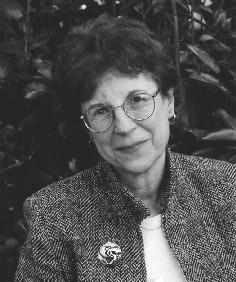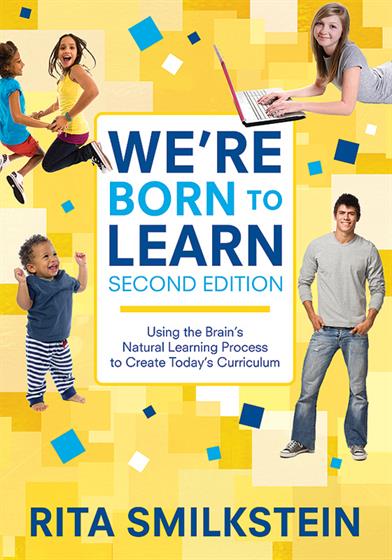
Hands-on, Practical Guidance for Educators
From math,
literacy, equity, multilingual learners, and SEL, to assessment, school counseling,
and education leadership, our books are research-based and authored by experts
on topics most relevant to what educators are facing today.
We're Born to Learn
By: Rita Smilkstein
This updated edition of the award-winning bestseller shows teachers how to help students become the motivated, successful, and natural learners they were born to be.
- Grade Level: PreK-12, Elementary, Secondary
- ISBN: 9781412979382
- Published By: Corwin
- Year: 2011
- Page Count: 272
- Publication date: April 04, 2014
Price: $43.95
For Instructors
When you select 'request review copy', you will be redirected to Sage Publishing (our parent site) to process your request.
Description
"Applying the natural human learning process described in the book transformed my students' ability to learn. No teacher, new or experienced, should enter any classroom without a copy of this book."
—Patricia Jamie Lee, Educational Consultant
Many Kites Press, St. Paul, MN
Teach students to take responsibility for their own success!
This updated edition of the bestselling book on the brain's natural learning process brings new research results and applications in a power-packed teacher tool kit. Rita Smilkstein shows teachers how to create and deliver curricula that help students become the motivated, successful, and natural learners they were born to be. Updated features include:
- Guidelines for using the six-step Natural Human Learning Process (NHLP) for lesson planning and test preparation
- New information on how technology and Internet research affect student learning
- Practical methods for giving all students the tools they need to achieve
The author translates her unique research on students' critical and creative thinking into classroom strategies and sample lesson plans that will help to create a successful learning environment. Building on the content that earned the author an Educator's Award of the Year from the Delta Kappa Gamma International Society, We're Born to Learn provides teachers with practical methods for giving all students the metacognitive, motivational, and technological tools they need to take responsibility for their own achievement.
Key features
The updated edition includes:
- Step-by-step instructions to help educators conduct student research in their own classrooms to determine similarities and differences between individual learning processes
- Answers to how teachers might adapt to the widespread use of user-controlled technology both in and out of the classroom
- A chapter dedicated to explaining how the brain learns in accessible language to share with students, complete with diagrams depicting the parts of a neuron, growing dendrites, synapse communication, and the sections of the brain
- Emphasis on the imperative of emotionally safe classrooms, including discussion of self-image and positive and negative neural networks, and the way that feeling's physiological effect on the brain plays into a successful learning environment
- A section on learning styles, aptitude, preferences, and multiple intelligences, including learning type (visual, auditory, kinesthetic), gifted students, special needs learning differences, and students with ADD/ADHD
- Real life classroom examples of students' critical and creative thinking coupled with research on the NHLP (Natural Human Learning Process)
- a list of non-natural learning assumptions followed by a list of ways to change them to natural learning assumptions
- an examination of students—their emotions, similarities, and differences, including learning styles, multiple intelligences, and disabilities such as ADHD and autism—as a precursor to pointing out their own resources for achieving success as learners
- Self-evaluation tools to help students take responsibility for their own success, including pre- and post-evaluation forms for classroom use
- A discussion of how to help students use positive transfer to intervene in the natural constructive process of learning, including an example of a transfer problem from the authors' own time as a graduate student
- Updated discussion of student group instructional feedback, and how teachers can learn and improve from their student evaluations
- Procedural suggestions for exams and exam preparation
- Sample lesson plans for elementary- through college-level classrooms
- How to give students the matacognitive, motivational, and technological tools to help them take responsibility for their own success
Author(s)

Rita Smilkstein
Table of Contents
Foreword by James H. Berry
Preface
Acknowledgments
About the Author
Introduction
What This Book Is About
Why Study the Brain?
Experienced Educators and the Research
The Learning Paradigm
Assumptions
Where We Have Been
Where We Are Today
This Book
PART I: Research in the Classroom and in the Brain Lab
1. Learning and Teaching
Eye-Opening Experiences in the Classroom
The Natural Human Learning Process and Brain Research
The Breakthrough Classroom
The Research-Based Stages, Curriculum, and Lesson Plans
2. How People Learn: The Natural Human Learning Process (NHLP)
Critical and Creative Thinking by Infants and Children
An Example of Children’s Critical and Creative Thinking
Critical and Creative Thinking in School
The Natural Human Learning Process and School
The Natural Human Learning Process (NHLP) Research
After the Research Is Over
Research Reports
The Importance of Making Mistakes
Where We Go From Here
3. How the Brain Learns: The Brain’s Natural Learning Process
Introducing the Brain
Getting to Know the Brain
How the Brain Learns
Convergence of Ceiling Levels and Neural Networks
Pruning
Experience and Brain Growth
Constructivism
How the Brain Thinks and Remembers
The Brain’s Innate Resources and Rules
Children’s Brains and Adults’ Brains
The Brain Grows Holistically with Plasticity
Implications for Curriculum Development
What About Piaget?
The Breakthrough Theory of Learning
4. Personal Experience, Individual Differences, and Learning
Emotions and the Brain
Negative and Positive Self-Image Networks
Learning from Experience
Learning Styles, Preferences, and Multiple Intelligences
Gifted Students
Aptitudes
Special Needs, Learning Differences, Autism, ADD, and ADHD
The Seven Magic Words: See If You Can Figure It Out
Tests
Beyond Individual Differences
A Handout for Students
5. The Student’s Experience: Metacognition, Motivation, Self-Evaluation, Achievement, and Technology Self Taught
Metacognition and Motivation
Intrinsic Rewards
Removing the Barriers
Self-Evaluation and Metacognition
Another Metacognitive Experience
Achievement
Writing Samples
Age and Achievement
Technology Self Taught
PART II: Theory and Application
6. Sequencing of the Curriculum
Challenges
The Missing Link
Two Problems
Neuroscience and Education
Converging Research
The Theory and Guide
Putting the Theory into Practice
Thinking at Higher Levels
Constructing New Knowledge
Planning the Sequence of the Units or Topics in a Curriculum
Using a Causal Sequence
Learning Activities for Units and Topics
The First Activity
Two Classroom Examples
Students and the NHLP
Developing a Curriculum
Young Students Thinking at a High Level
The NHLP in the Classroom
7. The Pedagogical Model and Guidelines
Transfer
Four Effective Instructional Practices
NHLP Pedagogical Guidelines
Assessment
Education Courses or Faculty Development Programs
Good News
PART III: Using the Brain’s Natural Learning Process to Create Curriculum
8. Brain-Based, Natural Learning Across the Curriculum
The Seven Magic Words in Action
Safety
Respect
The Opportunity to Learn Naturally
The Critical First Stages
The Introduction-to-Poetry Unit
Front Loading
A Science Learning Activity about the Concept of Buoyancy
A Unit for Library Orientation
A Unit for Introduction to Safety Procedures
A Science Learning Activity about Water
A Unit for Learning How to Take Lecture Notes
The NHLP Planning Guidelines and Pedagogy
9. Curriculum Development for Units, Courses, and Programs
Where to Start
Curriculum Development Guidelines
A Unit on Literal and Inferential Meaning
A Unit on an Introduction to Egypt
A Unit on an Introduction to Fractions
A Basic Grammar Curriculum: A Sequence of Units for a Whole Course
A Developmental English Curriculum: Courses in a Program
References
General Bibliography
Index
Reviews
"I encountered Rita Smilkstein's work as I struggled with teaching entry level students on an Indian Reservation. The natural human learning process described in the book transformed my experience. My students were engaged, attending classes, and reprogramming their past from the frame of 'failure' to the frame of 'born to learn.' No teacher, new or experienced, should enter any class without a copy of this book."Patricia Jamie Lee, Educational Consultant
Many Kites Press, St. Paul, MN
"Dr. Rita Smilkstein has inspired thousands of students and educators with her practical application of the Natural Human Learning Process. This new edition brings us up-to-date, and maintains the clarity and generosity of spirit that is Smilkstein's trademark. Her enthusiasm rekindles the joy of learning that is hard-wired in all of us. If you read one book this year, make it We're Born to Learn, then put it into action."Laura Symons, Assistant Professor
Piedmont Community College, Charlottesville, VA
"We're Born to Learn is one of the most valuable instructional tools teachers will ever use. Knowing 'how' students learn should be absolutely mandatory, yet is rarely taught in college prep. All teachers believe that they are teaching, but few know how students actually learn, and don't consider how the brain processes new information while developing their lesson plans. Dr. Smilkstein likens the learning brain to twigs on a tree; the twigs grow from a branch that is already there (prior knowledge). After reading this book, the most treasured seven words in every classroom will be, 'See if you can figure this out.'"Dr. Deborah Daiek, Associate Dean
Schoolcraft College, Livonia, MI
"Dr. Rita Smilkstein offers a prescription for what ails our developmental students: lack of critical thinking, lack of understanding of the learning process, etc. While the previous edition is a must read, this latest edition is teaching and learning’s pharmacology textbook…a collector’s item for developmental education."Reneau Waggoner, Associate Professor
Jefferson Community and Technical College, Louisville, KY
"This book is a must read for anyone with ADHD or ADD students who are drowning in the public education system. The author presents recent research that opens the door for teachers to immediately create an environment conducive to helping these students learn."Karen J. Sides, Dean of Interdisciplinary Programs
St. Philip's College, San Antonio, TX
"Packs in in practical methods for achievement and is a top pick for any education collection."James A. Cox, Editor-in-Chief
The Midwest Book Review, August 2011
Other Titles in: Teaching Methods & Learning Styles | Brain-Friendly Teaching & Learning | Critical Thinking Skills
For Instructors
When you select 'request review copy', you will be redirected to Sage Publishing (our parent site) to process your request.

